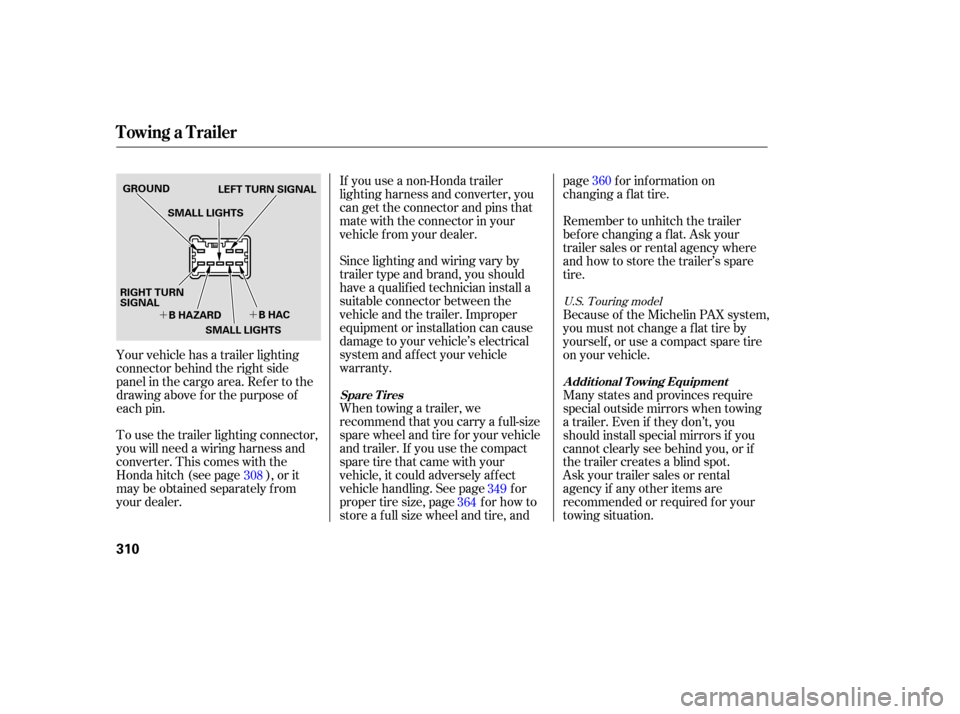Page 300 of 414

Check the brakes after driving
through deep water. Apply the
brakes moderately to see if they f eel
normal. If not, apply them gently and
f requently until they do. Be extra
cautious in your driving.
The hydraulic system that operates
the brakes has two separate circuits.
Each circuit works diagonally across
the vehicle (the lef t-f ront brake is
connected with the right-rear brake,
etc.). If one circuit should develop a
problem, you will still have braking
at two wheels.If the brake pads need replacing, you
will hear a distinctive, metallic
screeching sound when you apply
the brake pedal. If you do not have
the brake pads replaced, they will
screech all the time. It is normal f or
the brakes to occasionally squeal or
squeak when you apply them.
Your vehicle is equipped with disc
brakes at all f our wheels. A power
assist helps reduce the ef f ort needed
on the brake pedal. The anti-lock
brake system (ABS) helps you retain
steering control when braking very
hard.
Constant application of the brakes
when going down a long hill builds
up heat and reduces their ef f ective-
ness. Use the engine to assist the
brakes by taking your f oot of f the
accelerator and downshif ting to a
lower gear. Resting your f oot on the pedal keeps
the brakes applied lightly, builds up
heat, and reduces their ef f ectiveness.
It also keeps your brake lights on all
the time, conf using drivers behind
you.
Braking System
Braking System Design
Brake Wear Indicators
Driving
299
Page 305 of 414

If a f lat tire is causing the low tire
pressure indicator to come on, you
will see the above message in the
multi-inf ormation display.
It is possible that the pressures
shown in the multi-inf ormation
display and the pressures you
manually measure are slightly
dif f erent.
If the dif f erence is signif icant and
you cannot make the low tire
pressure indicator and message in
the multi-inf ormation display go out
after inflating the tires to the
specified values, have your dealer
check the system as soon as possible.
When the low tire pressure indicator
is on, one or more of your tires is
signif icantly under-inf lated. You
should stop and check your tires as
soon as possible, and inflate them to
the proper pressure as indicated on
the vehicle’s tire inf ormation placard.
Driving on a signif icantly under-
inf lated tire causes the tire to
overheat and can lead to tire failure.
Under-inf lation also reduces f uel
efficiency and tire tread life, and may
af f ect the vehicle’s handling and
stopping ability. Each tire, including
the spare should be checked
monthly when cold, and set to the
recommended inf lation pressure as
specif ied in the vehicle placard and
owner’s manual (see page ).
346
Tire Pressure Monitoring System (TPMS)
Low Tire Pressure
Indicator
304
Page 310 of 414

CONT INUED
If you choose electric brakes, be
sure they are electrically actuated.
Do not attempt to tap into your
vehicle’s hydraulic system. No
matter how successf ul it may seem,
any attempt to attach trailer brakes
to your vehicle’s hydraulic system
will lower braking ef f ectiveness and
create a potential hazard.Trailer lights and equipment must
comply with f ederal, state, province,
and local regulations. Check the
requirements f or the areas where
you plan to tow, and use only
equipment designed f or your vehicle.
If the total trailer weight exceeds
2,000 lbs (900 kg), you should install
a sway control device to minimize
swaying that can occur in crosswinds
and in normal and emergency
driving maneuvers. Your trailer
maker can tell you what kind of sway
control you need and how to install it.
To help prevent overheating, a
transmission f luid cooler and a
power steering f luid cooler are
required f or trailer towing. These
coolers are available only f rom your
Honda dealer. Honda recommends that any trailer
having a total weight of 1,000 lbs
(450 kg) or more be equipped with
its own electric or surge-type brakes.
Seeyourtrailerdealerformore
inf ormation on installing electric
brakes.
Towing a Trailer
Trailer Brakes
Trailer Lights
Sway Cont rol
T ransmission Fluid Cooler andPower St eering Fluid Cooler
Driving
309
Page 311 of 414

�´�´
To use the trailer lighting connector,
you will need a wiring harness and
converter. This comes with the
Honda hitch (see page ), or it
may be obtained separately from
your dealer. If you use a non-Honda trailer
lighting harness and converter, you
can get the connector and pins that
mate with the connector in your
vehicle f rom your dealer.
Since lighting and wiring vary by
trailer type and brand, you should
have a qualif ied technician install a
suitable connector between the
vehicle and the trailer. Improper
equipment or installation can cause
damage to your vehicle’s electrical
system and af f ect your vehicle
warranty.
When towing a trailer, we
recommend that you carry a f ull-size
spare wheel and tire for your vehicle
and trailer. If you use the compact
sparetirethatcamewithyour
vehicle, it could adversely af f ect
vehicle handling. See page f or
proper tire size, page f or how to
store a f ull size wheel and tire, andpage f or inf ormation on
changing a f lat tire.
Askyourtrailersalesorrental
agency if any other items are
recommended or required f or your
towing situation. Many states and provinces require
special outside mirrors when towing
a trailer. Even if they don’t, you
should install special mirrors if you
cannot clearly see behind you, or if
the trailer creates a blind spot. Because of the Michelin PAX system,
youmustnotchangeaflattireby
yourself , or use a compact spare tire
on your vehicle. Remember to unhitch the trailer
bef ore changing a f lat. Ask your
trailer sales or rental agency where
and how to store the trailer’s spare
tire.
Your vehicle has a trailer lighting
connector behind the right side
panel in the cargo area. Ref er to the
drawing above f or the purpose of
each pin. 308 349
364 360
U.S. Touring model
Spare Tires A ddit ional T owing Equipment
Towing a Trailer
310
GROUND
LEFT TURN SIGNAL
SMALL LIGHTS
B HAZARD B HAC
RIGHT TURN
SIGNAL
SMALL LIGHTS
Page 312 of 414

When preparing to tow, and bef ore
driving away, be sure to check the
f ollowing:The vehicle has been properly
serviced, and the tires, brakes,
suspension, cooling system, and
lights are in good operating
condition.
The trailer has been properly
serviced and is in good condition.
All weights and loads are within
limits.
Thehitch,safetychains,andany
other attachments are secure. All items in or on the trailer are
properly secured and cannot shif t
while you drive.
Your vehicle tires and spare are
properly inf lated, and the trailer
tires and spare are inf lated as
recommended by the trailer
maker.
The added weight, length, and
height of a trailer will af f ect your
vehicle’s handling and perf ormance,
so driving with a trailer requires
some special driving skills and
techniques.
Foryoursafetyandthesafetyof
others,taketimetopracticedriving
maneuvers bef ore heading f or the
open road, and f ollow the guidelines
below.
Drive slower than normal in all
driving situations, and obey posted
speed limits f or vehicles with trailers.
Use the D position when towing a
trailer on level roads. Do not exceed
55 mph (88 km/h). At higher speeds,
the trailer may sway or affect vehicle
handling.
Towing a Trailer
Pre-T ow Checklist
Driving Saf ely With a T railer
T owing Speeds and Gears
Driving
311
Page 314 of 414

This section explains why it is
important to keep your vehicle well
maintained and how to f ollow basic
maintenance saf ety precautions.......................
Maintenance Saf ety .314
....................
Maintenance Minder . 315
....................
Maintenance Record .325
..............................
Fluid Locations .327
........................
Adding Engine Oil .328
.........
Changing the Oil and Filter . 329
..............................
Engine Coolant .331
....................
Windshield Washers .333
....
Automatic Transmission Fluid . 334
....................................
Brake Fluid .335
....................
Power Steering Fluid . 336
....................................
Timing Belt .336
.............................................
Lights .337
................
Cleaning the Seat Belts . 343
.....................................
Floor Mats .343
.................................
Wiper Blades .344
...............................................
Tires .346
...................
Checking the Battery . 352
.............................
Vehicle Storage .353
This section also includes
instructions on how to read the
maintenance messages in the
odometer/trip meter display or
multi-Inf ormation display, a
maintenance record, and instructions
for simple maintenance tasks you
may want to take care of yourself.
If you have the skills and tools to
perf orm more complex maintenance
tasks on your vehicle, you may want
to purchase the service manual. See
page f or inf ormation on how to
obtain a copy, or see your dealer.
401
Maintenance
Maint enance
313
Page 324 of 414

�µ
�µ
�µ
�µ
�µ
�µ
�Ì
U.S. Vehicles:
Youshouldcheckthefollowing
items at the specif ied intervals. If
you are unsure of how to perf orm
any check, turn to the appropriate
page listed. Lights Check the operation of
the headlights, parking lights,
taillights, high-mount brake light,
and license plate lights monthly.
See page .
Engine coolant level Check the
radiator reserve tank every time
you f ill the f uel tank. See page . Engine oil level Check every
time you fill the fuel tank. See
page .
Automatic transmission Check
the f luid level monthly. See page .
Brakes Check the f luid level
monthly. See page .
Tires Check the tire pressure
monthly. Examine the tread f or
wear and foreign objects. See page .
According to state and federal
regulations, f ailure to perf orm
maintenance on the items marked
with will not void your emissions
warranties. However, all
maintenance services should be
perf ormed in accordance with the
intervals indicated by the odometer/
trip meter display or the multi-
inf ormation display.
281
282
334 335
347 337
Maintenance, replacement, or
repair of emissions control
devices and systems may be done
by any automotive repair
establishment or individual using
parts that are ‘‘certif ied’’ to EPA
standards. Owner’s Maintenance Checks
Maintenance Minder
Maint enance
323
Page 338 of 414
Your vehicle has halogen headlight
bulbs, two on each side. When
replacing a bulb, handle it by its base
and protect the glass from contact
with your skin or hard objects. If you
touch the glass, clean it with
denaturedalcoholandacleancloth.The high beam headlight bulb and
the low beam headlight bulb are
replaced the same way.Open the hood. To change the
high beam headlight bulb on the
passenger’s side, remove the
power steering f luid reservoir
f rom its holder by pulling it
straight up.
Theheadlightswereproperlyaimed
when your vehicle was new. If you
regularly carry heavy items in the
cargo area or pull a trailer,
readjustment may be required.
Adjustmentsshouldbedonebyyour
dealer or other qualif ied mechanic.
1.
CONT INUED
Lights
Headlight A imingReplacing a Headlight Bulb
Maint enance
337
Halogen headlight bulbs get very hot
when lit. Oil, perspiration, or a scratch
on the glass can cause the bulb to
overheat and shatter.